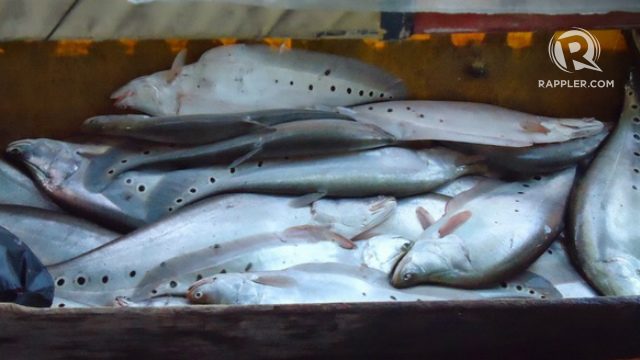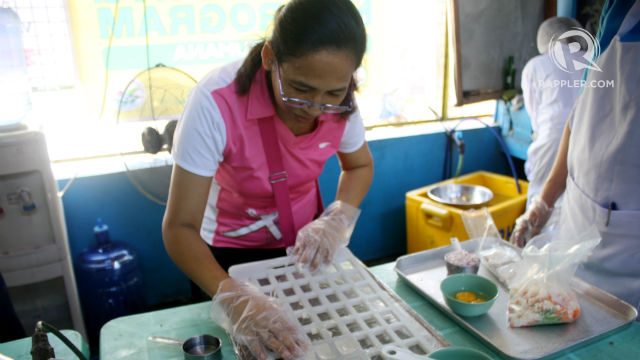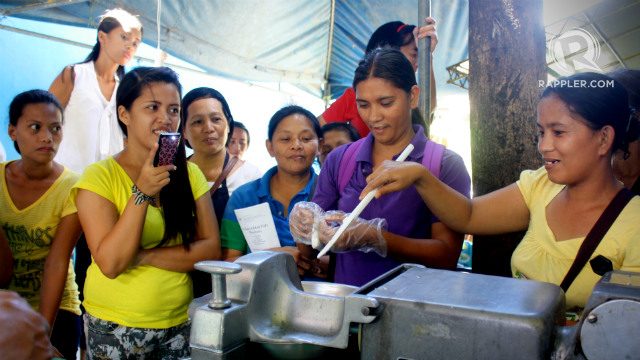SUMMARY
This is AI generated summarization, which may have errors. For context, always refer to the full article.

MANILA, Philippines (UPDATED) – One morning in Barangay Tumana, 20 mothers huddled around a table, barely able to contain their excitement while watching Vilma Layes finish making a batch of fish tofu from “knife fish” threatening the local fish industry.
The knife-shaped fish were previously reported to be multiplying in Laguna Lake, displacing native species, and threatening the livelihood of fisherfolk.
The threat however was sought to be reversed by representatives of the Fisheries Post Harvest Division of the Bureau of Fisheries and Aquatic Resources (BFAR) who conducted a food processing seminar in the Tumana Day Care Center in Marikina.
“Dahan-dahan lang (Be careful),” Vilma was told as she slowly lifted the mold. She smiled when she saw the bean curd on the tray in perfect blocks. She was one of several mothers being taught in a two-day workshop how to make processed food out of knife fish: tofu, hotdogs, sausages, nuggets, burger patties, noodles, siomai, kikiam, embutido, and of course, fish balls.
The workshop is part of a collaborative effort among different government agencies, local government units (LGUs), and other institutions to contain the knife fish boom in Laguna de Bay and to transform the “pest” into value-added food products and fish meals.
The project originally targeted fishing communities along the lake, but Golden Grip Universal Foundation partnered with BFAR and has included Tumana in the program.
“The number one concern here is to address yung number one problem din nila, which is hunger,” said Golden Grip president Maria Magdalena Ip.
“And when we say hunger, it’s not just giving them food for a day, but [teaching] them how to fish so our efforts will be more sustainable,” she added in a mix of English and Filipino.

Layes, a housewife and a mother of 4, said she joined the seminar so she can help her husband, a barber, pay for the family expenses.
“Para naman umangat-angat nang kaunti (So my family’s life will improve even a little).”
Knife fish boom
BFAR noticed the overpopulation of knife fish in 2012. They were reportedly being bred in the Philippines as an ornamental species for aquariums, but they somehow found their way into Laguna de Bay.
In a previous interview, BFAR director Asis Perez said: “It is carnivorous. It will compete with our existing natural fish.”
Fishermen groups have also complained that the knife fish, which can grow up to 51 cm long, have contributed to the decreasing number of native fish in the lake.
The following year, a joint livelihood project was spearheaded by BFAR, the Laguna Lake Development Authority (LLDA), the Department of Trade and Industry (DTI), and the Department of Social Welfare and Development (DSWD) to provide financial, technical, and augmentation support to address the knife fish overpopulation in Laguna de Bay.
BFAR transferred a total of P350,000 to 7 coastal municipalities in Laguna and 3 municipalities in Rizal. Each kilo of knife fish retrieved was bought from fishermen for P20/kilo; 74 tons of knife fish were collected from February 2013 to December 2014.
The DSWD also implemented a knife fish retrieval effort under the Cash for Work Program involving Pantawid Pamilyang Pilipino Program beneficiaries in 2014.
A pest no more
The inter-agency technical working group (TWG) on the containment of knife fish then explored the economic benefits of the species.
According to BFAR, “the activity gave supplemental income to the fishermen and provided raw materials for the development of knifefish based value added products.”
Aside from food products, knife fish can also be turned into fish meals for mudcrab, maliputo, sea bass, and tilapia.
The TWG is researching on how to transform knife fish skin into leather as well.
In February 2015, the TWG established the first knife fish processing plant in Sitio Balanga, Barangay Pinagbayanan, Pila, Laguna.
‘Power to purchase’

This is what Golden Grip dreams for Barangay Tumana.
The foundation’s long-term goal for co-hosting the technical training seminar is to help the TWG create a knife fish processing plant in Iwahig, a former dumpsite in the said barangay.
“[We want this for the community] so there will be employment. They will have salaries. They will have the power to purchase,” said Ptr. Ed San Agustin, a missionary from the Christian Aid Ministry and the executive assistant for operations in Golden Grip.
“Hindi na sila kailangang manghingi, mangutang (They will no longer need to beg or borrow money),” he added.
Marivic Alonzo, 34, was another mother who attended the seminar. A mangangalakal, she goes to houses and grocery stores to buy cartons, then sells them to junk shops. On the average, she earns P200 to P400 a day.
Her husband Leo, 32, is a painter in Batangas. While he earns around P400 daily, it takes a while for him to send money back home, which is why Marivic and their 7 children need to make do with what she earns most of the time.
She said the knife fish processing seminar is a blessing to her family. “Dagdag income… para matuto rin ako ng ibang dapat pagkakitaan (Extra income…. so I will have a new source of livelihood as well),” said Marivic.
“Saka mas marami akong nakikilalang kaibigan. Yun ang gusto ko (And I get to meet new friends. That’s what I want).” – Rappler.com
Editor’s Note: In a previous version of this story we said knife fish were also called “arowanas”. They are a different type of species and not the ones found in Laguna Lake. We have deleted the reference to them.
Add a comment
How does this make you feel?
There are no comments yet. Add your comment to start the conversation.